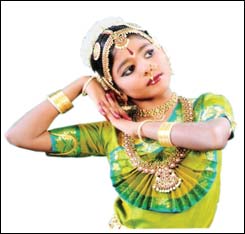Emerging trends in Bharatha Natyam repertoire
Subashini Pathmanathan
|

Music and emotions play an important role in a
performance |
Ancient art forms like Bharatha Natyam, like most other ancient art
forms inevitably has under gone changes. Many changes were introduced in
different areas during the 20th and early 21st century. However the
basic structure of Bharatha Natyam has not been altered.
Bharatha Natyam, which originated in the temples and moved to the
palaces of princes, and maharajahs, eventually moved to dance halls, in
the 20th century.
In the 19th century, a dance recital followed an order that was
devised by the Tanjore Quartette. However, to minimise the time today in
normal recital, (not arangetrams) Jatheesvaram and sabtham are
frequently omitted.
In the early days a Bharatha Natyam, recital started with Alarippu.
However today most of the Bharatha Natyam recitals begin with
Pushpanjali, Panchamoorthy Anjali, Panchamoorthy Vanthanam, Gurupatha
Anjali, Mallaru, Thodayamangalam or Gowthavams, which involves the use
of Niutham and Nirthiyam together.
Today Salamu is known as Sabtham. The Sabtham is performed in Misra
Saapu Thala numbering seven in the thala scale. Originally the Sabtham
was sung in Kambothi raga but now it has meandered into Ragamaliga.
Varnam is the crowning piece in any Bharatha Natyam recital from
ancient times. In between the Pallavi, and Anupallavi it is customary to
use the oral Nattuvanga Jathi Sollukadu.
In recent times, some dance exponents omit the Nattuvanga Jathi
Sollukadu. This is because some dancers prefer to follow the original
composerís version.
|

Some dancers wish to follow the original composerís version |
Mostly the Varnams used in dance are Patha Varnams which means that
these compositions are most suited for the exposition of expression,
bavas, and rasas. There are some Bharatha Natyam exponents who insert
Oral Nattuvangam Jathis into the Padams, Keerthanams, even in folk songs
and kuravanchi. There is a growing tendency to insert oral Nattuvangam
Jathis in between the lines which enables one to compile adavus. So that
now Padams,Keerthanams, and Jaavalis, Nattuvanga Jathi Sollukadu are not
totally based on Nirthiyam alone. It is a combination of both Nirutham
and Nirthiyam.
In ancient times, the instruments used for Nirutham were called
Niruthangam. Those used for the songs were called Geethangam. However
this distinction does not at all exist today.
The tendency is to use particular musical instruments to display
certain emotions in between the song lines today. For instance the Veena
is used to display contemplative moods. Violin is used to portray
sorrow. Miruthangam, which is thala laya instrument, is used to display
the emotions like anger, veera or akangara. The flute is used to display
emotions like happiness and love.
These are some of the recent innovations. The basic concepts of
Bharatha Natyam remain the same. The changes have only occurred to meet
the challenges of modern times.
|



